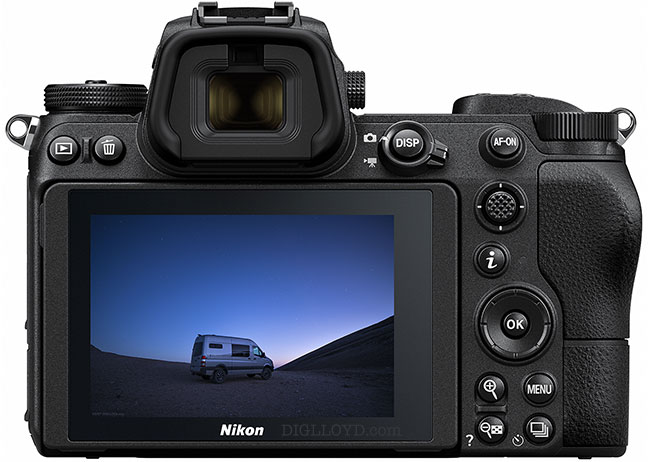Reader Comment: Nikon Z7 vs Nikon Z6 for Focusing Tracking and Noise
Brian K writes:
I’m quite happy with the Nikon Z7. It’s not perfect, but I prefer it over any camera I have ever owned.
[diglloyd: in total, the Nikon Z7/Z6 have the best ergonomics/haptics and travel size camera/lenses combo on the market. Little surprise to see Ming Thein carrying the Nikon Z7 + the Nikon NIKKOR Z 24-70mm f/4 S while traveling].
My only major complaint is the focus lag for rapidly moving subjects—something that becomes an issue with my rapidly moving 5 year old son. I’m hoping this gets improved in a subsequent iteration. The counterpoint is that setting AF to area AF in continuous focus mode is *really* useful unless the subject is moving quickly. For non-tripod work it has become my AF mode of choice. Point the camera at the area you want to be in focus, half-press the shutter to lock it on that area (with the subsequent yellow rectangle), and then recompose as needed. While not perfect, it does a decent job of continuously acquiring focus on the area you chose. When Eye AF gets activated when people are in the frame, this gets even better. Easy to switch between eyes (or people). Again not perfect, but it has worked pretty well for me. When it doesn’t work (by picking the wrong area to lock onto), it’s fairly easy to start over (by hitting the OK button to reset the area of AF).
 Nikon Z7
Nikon Z7My actual question to you involves a comparison between the Z7 and Z6. I have no idea if the Z6 is better able to handle continuous AF changes with rapidly moving subjects. Perhaps the lower MP of the sensor allows it to focus faster/more accurately with rapidly moving subjects? It has fewer AF points than the Z7 which makes me think the answer is no, but possible I’m not thinking about everything.
The other question (which is actually more important to me) is whether the Z6 might handle noise better than the Z7. The two share the same generation of sensor, but the Z6 sensor is less dense than the Z7 sensor. So the photosites are bigger? Which should result in a better ability to distinguish signal from noise?
I have a specific application in mind behind my question. With my son being 5 yrs old, he attends many birthday parties at indoor bouncy houses. The light isn’t great. Freezing motion of my son (or the other kids) jumping requires a shutter speed of at least 1/125th sec and ideally faster (1/200, 1/250, 1/300). With an f/2.8 zoom the ISO values start getting into the unacceptable range and even with an f/1.4 lens they can get fairly high (and focus errors get magnified at f/1.4 and DOF can be too shallow even without focus errors).
So if the Nikon Z6 can handle noise better by even a stop, it might be a better body for this specific application. If it can handle noise better by more than a stop, that would be even better.
Though it’s somewhat crazy, I’m considering buying a Z6 specifically for this type of shooting situation—not for landscapes or tripod work where I care about detail, but for action shots in poor light. Not for the higher FPS capture, but specifically to get better IQ at a high ISO with rapidly moving subjects. Am I thinking about this correctly? Am I missing something?
DIGLLOYD: taking digital sensor noise first: given equivalent technology, two sensors of the same size but different resolution collect the same amount of total light. The sensor with lower resolution has larger photosites and in theory will yield a higher signal/noise ratio per pixel.
The f/2.8 lens speed might be hurting AF speed with most cameras but since Nikon stops down for focusing, it would not help to use an f/1.8 prime (unless the firmware now supports opening the lens in dim light to focus, in which case focus shift becomes a problem).
However, the noise on a per-image basis is not per pixel, it is per-image. So the appropriate comparison is to downsample the 45MP Nikon Z7 image to the matching 24MP size of the Nikon Z6 in order to properly compare it. Excluding extremely high ISO values perhaps (where the S/N ratio becomes very poor and thus the dominating factor), I have found that the higher resolution camera is usually preferable even when noise is a concern, because visible noise is usually no worse, but it eliminates other digital artifacts by virtue of oversampling. With a small amount of chroma noise reduction, the downsampling (using Bicubic Sharper) produces a superior overall image with much less moiré, color aliasing and with superior micro contrast.
In other words and excepting very high ISO, all other things being equal I would stick with the Nikon Z7.
Autofocus speed: I don’t have any special knowledge of Nikon Z6 vs Nikon Z7 autofocus capability and cannot speak to that. I presume the technology is the same, but that the Z7 can ultimately focus more accurately in a sense, because it does so at higher resolution. Again, that means that downsampling to 24MP then comparing the detail/accuracy may win out in favor of the Z7.




























